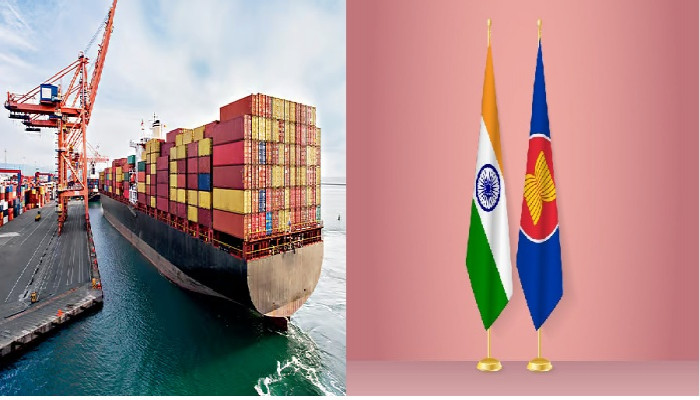India-ASEAN Free Trade Agreement Led to Significant Trade Imbalances
- In Economics
- 12:29 PM, Jul 20, 2025
- Viren S Doshi
Introduction to ASEAN and the Free Trade Agreement
The Association of Southeast Asian Nations (ASEAN), established on August 8, 1967, comprises ten member states: Brunei, Cambodia, Indonesia, Laos, Malaysia, Myanmar, the Philippines, Singapore, Thailand and Vietnam. With a combined population of approximately 670 million and a gross domestic product (GDP) of $3.4 trillion in 2023, ASEAN is a significant economic bloc promoting regional trade, investment and stability.
The India-ASEAN Free Trade Agreement (FTA), officially the ASEAN-India Trade in Goods Agreement (AITIGA), was signed on August 13, 2009 and entered into force on January 1, 2010. It aimed to liberalise trade by reducing tariffs on over 90% of goods, including palm oil, pepper, tea, and coffee, thereby creating a free trade area that covers roughly 1.9 billion people.
However, the agreement’s exclusion of services and labour markets, combined with exploitation by the Chinese Communist Party (CCP)-occupied China, has led to significant trade imbalances affecting India adversely.
The nationalist government of Prime Minister Narendra Modi, echoing the tariff-driven policies of the Trump administration, is adopting a resolute stance, bolstered by Quality Control Orders (QCOs), to address these flaws, potentially considering exiting the FTA if revisions fail to deliver equitable outcomes.
Historical Context and the UPA Government’s Role
The AITIGA originated from India’s Look East Policy, launched in 1991 under open market proponent Prime Minister P.V. Narasimha Rao to strengthen economic and strategic ties with Southeast Asia.
This policy was advanced under the Congress-led United Progressive Alliance (UPA) government, led by Economist Prime Minister Manmohan Singh from 2004 to 2014. Negotiations for the AITIGA began in 2003 and concluded in 2009, focusing on tariff reductions for goods to enhance market access. However, the UPA government’s decision to exclude services and labour markets—sectors where India excels due to its robust information technology (IT) and pharmaceutical industries—was a critical “oversight” by this centre-left government actually led by Sonia “Gandhi” and her son Rahul “Gandhi” known for signing a “secret” undisclosed agreement with the Chinese Communist Party - CCP in 2008 just one year prior to the signing of this FTA by Manmohan Government of India.
This skewed agreement limited India’s ability to leverage its competitive advantages in services and labour, favouring ASEAN’s goods-based economies, which were thoroughly infiltrated by the CCP.
The Modi government, driven by a nationalist “India First” agenda, has criticised the UPA-era FTA as poorly structured. Commerce Minister Piyush Goyal has described it as lopsided, arguing it failed to protect Indian industries from unfair competition, setting the stage for a tougher approach to renegotiate or terminate the agreement.
Structural Flaws and the Role of CCP-Occupied China
A significant flaw in the AITIGA is its weak rules of origin (ROO) provisions, which determine the eligibility of goods for tariff concessions by verifying their country of origin. The agreement requires that goods undergo substantial transformation in an ASEAN country or have at least 35% value addition to qualify for benefits. However, lax enforcement and inadequate verification mechanisms have allowed CCP-occupied China to route goods through ASEAN nations, bypassing India’s tariffs. This has led to “dumping” of low-cost products, such as electronics, steel and chemicals, in India, undermining domestic industries.
For example, ASEAN countries like Vietnam and Malaysia have become conduits for CCP-occupied China’s exports, with minimal processing qualifying goods for tariff-free entry into India.
The Modi government, echoing the Trump administration’s nationalist trade policies, views this exploitation as a threat to India’s economic sovereignty. It has prioritised stricter ROO enforcement and the implementation of QCOs, which mandate compliance with Bureau of Indian Standards (BIS) for imported goods, to ensure only high-quality, genuinely ASEAN-produced goods benefit from the FTA. This aligns with the “Atmanirbhar Bharat” (Self-Reliant India) initiative to protect domestic manufacturing.
Trade Trends and India’s Economic Burden
The AITIGA has significantly worsened India’s trade balance with ASEAN.
In the fiscal year 2010-11, India’s trade deficit with ASEAN was $7.97 billion, with exports at $25.63 billion and imports at $33.60 billion.
By fiscal year 2022-23, the deficit surged to $43.57 billion, with exports at $44 billion and imports at $87.57 billion, according to India’s Ministry of Commerce and Industry. Preliminary data for 2023-24 suggest the deficit remained high, estimated at $43.6 billion, with exports at $41.2 billion and imports at $84.8 billion.
Key sectors affected include steel, electronics, chemicals and textiles, where domestic industries face competition from low-cost imports, often originating from CCP-occupied China.
The Federation of Indian Chambers of Commerce and Industry (FICCI) has highlighted non-tariff barriers (NTBs) imposed by some ASEAN countries, such as complex certification requirements, which restrict Indian exports while allowing unrestricted imports into India.
The exclusion of services and labour mobility has further limited India’s ability to leverage its strengths in IT, pharmaceuticals and professional services, contributing to an economic burden estimated to cost Indian industries billions annually due to lost competitiveness.
QCOs, introduced for products like steel, electronics, and chemicals (e.g., Steel and Steel Products QCO, 2018, and Electrical Equipment QCO, 2020), have aimed to curb substandard imports from ASEAN and CCP-occupied China. However, enforcement challenges and ASEAN’s resistance to aligning with BIS standards have limited their effectiveness, exacerbating the trade imbalance.
Modi Government’s Tough Stance and Ongoing Negotiations
Since May 2023, the Modi government has pursued a review of the AITIGA, holding nine rounds of negotiations to address the trade deficit, weak ROO provisions, and substandard imports. The tenth round is scheduled for mid-August 2025 in New Delhi. Frustrated by ASEAN’s slow progress, India has warned of invoking the FTA’s termination clause, which allows termination with 12 months’ notice.
Commerce Minister Piyush Goyal has taken a hardline stance, reportedly describing some members of ASEAN as the “B team” of CCP-occupied China due to its role in facilitating Chinese goods entering India under the guise of ASEAN origin (The Hindu, July 7, 2025). Goyal has emphasised the role of QCOs, demanding that ASEAN imports comply with BIS standards to protect Indian industries from low-quality goods. He has also pushed for equitable market access to address NTBs, reflecting a nationalist approach. Industry stakeholders, including FICCI, have urged a comprehensive overhaul to strengthen ROO and integrate QCO compliance into the FTA framework, aligning with India’s self-reliance goals.
Impact of Quality Control Orders (QCOs)
India’s QCOs, issued under the BIS Act, 2016, mandate quality standards for imported goods in sectors like steel, electronics, chemicals and textiles to protect consumers and domestic industries. Since 2018, over 150 QCOs have been implemented, covering products like steel (e.g., Steel and Steel Products QCO, 2018), electrical equipment (e.g., Electrical Equipment QCO, 2020), and toys (e.g., Toys QCO, 2020). These orders require imports to carry the BIS mark, ensuring compliance with safety and quality norms.
In the context of the AITIGA, QCOs aim to curb the influx of substandard goods from ASEAN countries, particularly those originating from CCP-occupied China, which exploit weak ROO provisions.
However, QCOs have had mixed results. While they have raised quality standards for imports in sectors like steel and electronics, enforcement challenges persist due to limited testing infrastructure and bureaucratic delays. ASEAN countries, particularly Vietnam and Malaysia, have resisted aligning with BIS standards, citing compliance costs, which have strained FTA negotiations.
For instance, the steel industry, facing dumping of low-quality steel, has benefited from QCOs, with a 15% reduction in substandard imports since 2020, per FICCI reports. Yet, the chemical and electronics sectors continue to struggle, as QCO enforcement has not fully stemmed the tide of cheap imports.
The Modi government’s push to integrate QCO compliance into the AITIGA framework reflects its nationalist commitment to protect domestic industries, but ASEAN’s reluctance to adopt these standards risks further stalling talks and reinforcing India’s case for exiting the FTA.
Echoing the Nationalist Trump Administration’s Trade Policy
The Modi government’s nationalist policies are as strong as the Trump Administration’s nationalist policies, as can be seen in rejecting multilateral frameworks.
UPA government joined ASEAN, but the Modi government boldly and emphatically refused to join the Regional Comprehensive Economic Partnership (RCEP) in 2019, as RCEP is ASEAN + Big Five, including CCP-occupied China (the other four being Japan, South Korea, Australia and New Zealand, each of which has strong trade relations with India).
This underscores its clear policy vis-à-vis the CCP-occupied China’s monopolistic unfair trade practices. The Trump Administration is pursuing a similar line of action.
Conclusion: A Nationalist Reckoning for the FTA
The India-ASEAN FTA, signed in 2009 by centre left Congress led Manmohan Government a year after Congress CCP secret agreement, has burdened India with a $43.6 billion trade deficit by 2023-24, exacerbated by CCP-occupied China’s exploitation of weak ROO provisions, a practice Commerce Minister Goyal has condemned by calling ASEAN the “B team” of CCP-occupied China.
The nationalist Modi government, bolstered by QCOs to curb substandard imports echoing the Trump administration’s tariff-driven policies, is taking a resolute stance, demanding a renegotiated FTA that prioritises Indian industries.
With negotiations faltering, QCO enforcement challenges persisting, and the Trump Administration reshaping global trade, India is poised to exit the AITIGA if the August 2025 talks fail.
This reflects a strategic shift toward compact bilateral agreements in place of vulnerable multilateral agreements, particularly with the U.S., aligning Modi’s “India First” vision with Trump’s “America First” agenda to counter CCP-occupied China’s economic influence.
Disclaimer: The opinions expressed within this article are the personal opinions of the author. MyIndMakers is not responsible for the accuracy, completeness, suitability, or validity of any information on this article. All information is provided on an as-is basis. The information, facts or opinions appearing in the article do not reflect the views of MyindMakers and it does not assume any responsibility or liability for the same.







Comments